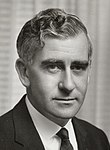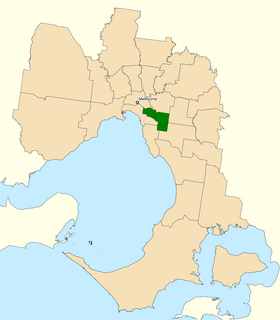The National Party of Australia is an Australian political party. Traditionally representing graziers, farmers, and rural voters generally, it began as the Australian Country Party in 1920 at a federal level. It would later briefly adopt the name National Country Party in 1975, before adopting its current name in 1982.
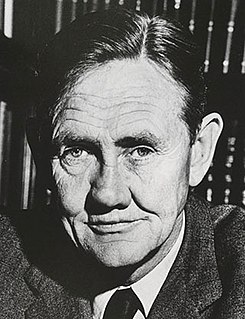
Sir John Grey Gorton was the 19th Prime Minister of Australia, in office from 1968 to 1971. He led the Liberal Party during that time, having previously been a long-serving government minister.
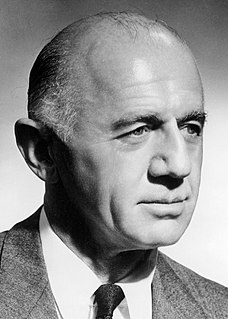
Sir William McMahon, was an Australian politician who served as the 20th Prime Minister of Australia, in office from 1971 to 1972 as leader of the Liberal Party. He was a government minister for over 21 years, the longest continuous ministerial service in Australian history.

Sir John McEwen, was an Australian politician who served as the 18th Prime Minister of Australia, holding office from 19 December 1967 to 10 January 1968 in a caretaker capacity after the disappearance of Harold Holt. He was the leader of the Country Party from 1958 to 1971.

The Deputy Prime Minister of Australia is the second-most senior officer in the Government of Australia. The office of Deputy Prime Minister was officially created as a ministerial portfolio in 1968, although the title had been used informally for many years previously. The Deputy Prime Minister is appointed by the Governor-General on the advice of the Prime Minister. When Australia has a Labor Government, the deputy leader of the parliamentary party holds the position of Deputy Prime Minister. When Australia has a Coalition Government, the Coalition Agreement mandates that all Coalition members support the leader of the Liberal Party becoming Prime Minister and mandates that the leader of the National Party be selected as Deputy Prime Minister.

Donald Leslie Chipp, AO was an Australian politician who was the inaugural leader of the Australian Democrats, leading the party from 1977 to 1986. He began his career as a member of the Liberal Party, winning election to the House of Representatives in 1960 and serving as a government minister for a cumulative total of six years. Chipp left the Liberals in 1977 to help create a new party, the Democrats, and famously promised to "keep the bastards honest". He won election to the Senate later that year, and led the party at four federal elections; after 1983 it held the sole balance of power in the Senate.

The McEwen Ministry was the 44th ministry of the Government of Australia. It was led by the country's 18th Prime Minister, John McEwen. The McEwen Ministry succeeded the Second Holt Ministry, which dissolved on 19 December 1967 following the disappearance of former Prime Minister Harold Holt. Since McEwen was the head of the Country Party, it was a caretaker ministry until the senior partner in the Coalition, the Liberal Party, could elect a new leader. John Gorton was ultimately elected on 9 January 1968, and he was sworn in as Prime Minister along with his ministry the following day.
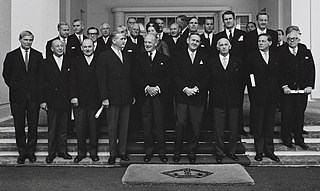
The First Gorton Ministry was the 45th ministry of the Government of Australia. It was led by the country's 19th Prime Minister, John Gorton. The First Gorton Ministry succeeded the McEwen Ministry, which dissolved on 10 January 1968 following the election of Gorton as Liberal leader after the disappearance of former Prime Minister Harold Holt. The ministry was replaced by the Second Gorton Ministry on 12 November 1969.

Federal elections were held in Australia on 2 December 1972. All 125 seats in the House of Representatives were up for election, as well as a single Senate seat in Queensland. The incumbent Liberal–Country coalition government, led by Prime Minister William McMahon, was defeated by the opposition Labor Party under Gough Whitlam. Labor's victory ended 23 years of successive Coalition governments that began in 1949.

Leslie Harry Ernest Bury CMG was an Australian politician who served in the House of Representatives between 1956 and 1974, representing the Liberal Party. He served in cabinet under Robert Menzies, Harold Holt, John McEwen, and John Gorton, most notably as Treasurer from 1969 to 1971 and Minister for Foreign Affairs in 1971.
A by-election was held for the Australian House of Representatives seat of Higgins on 24 February 1968. It was triggered by the presumed drowning death of the Prime Minister and Liberal Party MP Harold Holt on 17 December 1967.

The Holt Government was the federal executive government of Australia led by Prime Minister Harold Holt. It was made up of members of a Liberal-Country Party coalition in the Australian Parliament from 26 January 1966 – 19 December 1967.

The McMahon Government was the period of federal executive government of Australia led by Prime Minister William McMahon of the Liberal Party. It was made up of members of a coalition between the Liberal Party and the Country Party, led by Doug Anthony as Deputy Prime Minister. The McMahon Government lasted from March 1971 to December 1972, being defeated at the 1972 federal election. Writing for the Australian Dictionary of Biography, Julian Leeser describes McMahon's prime ministership as "a blend of cautious innovation and fundamental orthodoxy".

The Liberal Party of Australia held a leadership election on 20 January 1966, following the resignation of Robert Menzies. Harold Holt was elected unopposed as his successor, and was sworn in as prime minister on 26 January.

An election for the leadership of the Liberal Party of Australia took place on 20 December 1972, following former Prime Minister William McMahon's resignation after his defeat at the 1972 federal election. Billy Snedden was successful in winning the leadership, narrowly beating Nigel Bowen by 30 votes to 29 on the fifth ballot. The previous ballot was tied at 29 each, with one MP not voting. James Killen, John Gorton, and Malcolm Fraser had earlier been eliminated from contention, in that order.

The Liberal Party of Australia held a leadership spill on 7 November 1969, following the party's poor performance at the federal election on 25 October. Prime Minister John Gorton was re-elected as the party's leader, defeating challengers William McMahon and David Fairbairn.

The Liberal Party of Australia held a leadership spill on 10 March 1971. Prime Minister John Gorton called for a vote of confidence in his leadership, which was tied; he then declared his position vacant. William McMahon subsequently defeated Billy Snedden for the leadership, and was sworn in as prime minister on the same day. Gorton was elected as his deputy, defeating Malcolm Fraser and David Fairbairn.





